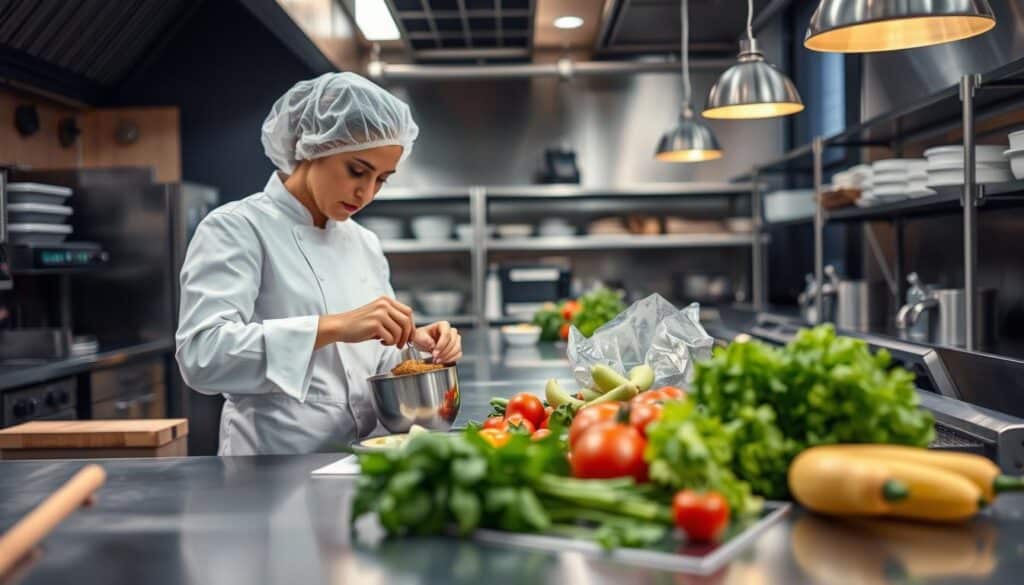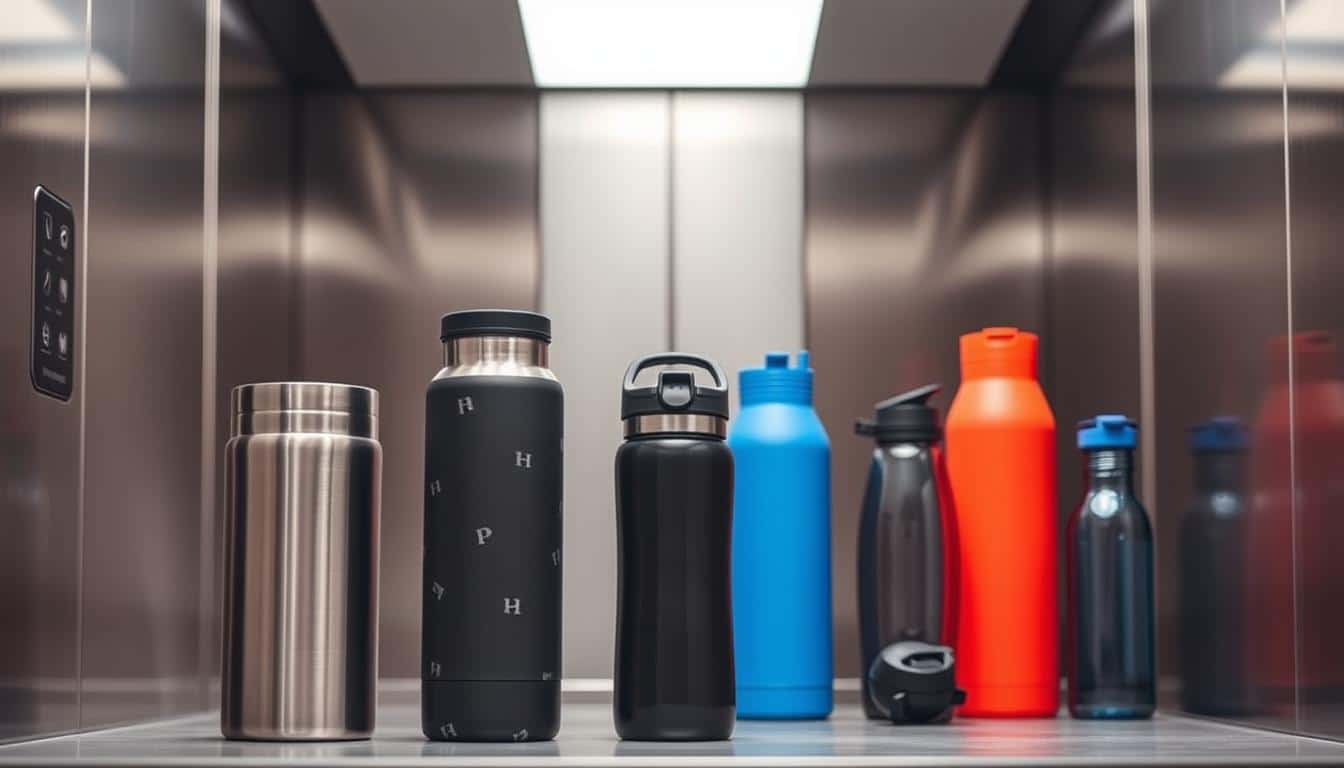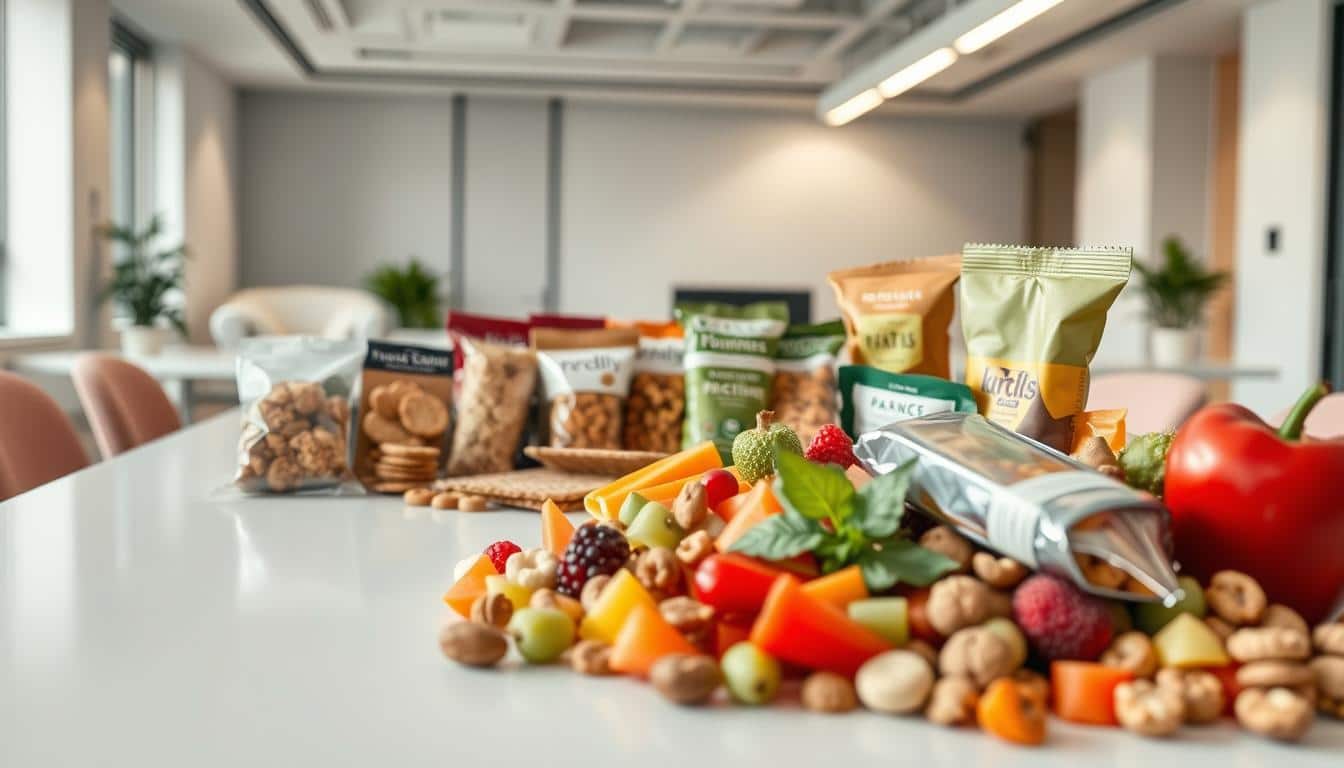In modern offices, keeping food safe in shared spaces like elevators is key. Elevator cleanliness affects employee health and lowers disease risks. Elevators are busy places, so we need clear cleaning rules to keep them germ-free. This guide will share top tips for keeping elevators clean for a healthier work atmosphere.
Understanding Food Safety in the Workplace
Food safety is key to keeping a clean workplace. It ensures that food prep and storage practices prevent contamination. About 48 million people get sick from foodborne illnesses each year in the U.S., highlighting the critical need for high food safety standards.
The Importance of Food Safety
Tight food safety measures protect workers and a company’s good name. When companies focus on food safety, their work environments become healthier. This boosts workers’ happiness and how much they get done. By practicing good food safety, companies can avoid the dangers of poor food handling.
Potential Risks of Foodborne Illnesses
Handling food safely in workplaces comes with challenges. Incorrect food handling can put workers at risk of getting sick from pathogens like Salmonella and E. coli. These illnesses can cause big medical bills and lawsuits. Knowing these dangers shows why it’s crucial to have good hygiene and regular food safety training at work.
Unique Sanitation Challenges in Office Elevators
Office elevators are busy spots, prone to catching germs. Their small size and heavy use make cleaning them harder. Recognizing the need for special cleaning methods is crucial because lots of people means more germs.
Common Contaminants Found in Elevators
Elevators can be full of germs that threaten our health. Here are some of the usual suspects:
- Bacteria from unwashed hands and surfaces
- Viruses transferred through contact with buttons and rails
- Food residues from employees transporting meals
These germs in elevators can spread sickness if we don’t keep them in check.
Impact of High Traffic on Cleanliness
Lots of people using elevators means more dirt and germs. With heavy use, it’s harder to keep them clean. This means we need stronger cleaning routines and constant checks. Getting cleaning right in elevators cuts down on foodborne illnesses at work.
Elevator-Safe Food Sanitation Guidelines for Offices
Making sure office elevators are safe for food involves a detailed cleaning plan. A good cleaning routine keeps things hygienic, lowering the chance of germs spreading. Cleaning times should increase with more elevator use to keep the space clean for everyone.
Establishing a Cleaning Schedule
Creating a clear cleaning schedule is key to keeping things sanitary. Here’s how to set one up:
- Check how often the elevator is used to figure out how often it needs cleaning.
- Keep track of all cleaning to make sure nothing is missed.
- Give cleaning duties to certain people or groups for regular upkeep.
Recommended Cleaning Products and Techniques
Choosing the right cleaning supplies is crucial for food safety. Pick products approved by the USDA for safety and effectiveness. We recommend:
- Sanitizers made specially for areas where food might touch.
- Microfiber cloths to clean surfaces well without leaving stuff behind.
- Good rinsing methods to get rid of any cleaning solution left over to prevent bacteria.
Adding these steps to your cleaning plan will make your office elevators much safer.
Implementing the Zone Concept in Office Environments
The Zone Concept is key for keeping office spaces clean, especially where food is around. It sorts surfaces by their risk of contamination. This makes cleaning more focused and effective. Paying extra attention to Zone 1 surfaces boosts cleanliness.
Identifying Zone 1 Surfaces
Zone 1 surfaces get in direct contact with food or see lots of human touch. These areas need thorough cleaning to prevent illness from spreading. Some common Zone 1 surfaces are:
- Elevator control panels
- Food storage areas next to elevators
- Serving counters and vending machines
Prioritizing Cleaning for Zone 1 Areas
Prioritizing cleaning cuts down on germ spread. Focusing on Zone 1 surfaces in cleaning schedules means the most critical spots are cleaned well. High-traffic areas could expose people to more germs. Inspecting these spots often and cleaning them carefully keeps the workplace healthy and safe.
The Role of Personal Hygiene in Food Safety
High employee hygiene standards are key to food safety in offices. These practices reduce the chance of illnesses and keep the workplace healthy. Every organization needs to follow these steps to stop cross-contamination and protect their team.
Best Practices for Employee Hygiene
There are important rules employees must follow for good hygiene. These practices are crucial:
- Washing hands well before making or eating food.
- Wearing the right, clean clothes while dealing with food.
- Staying away from food if sick or showing sickness signs.
With these practices, companies can build a clean culture. This greatly cuts down food contamination from bad hygiene.
The Importance of Handwashing Facilities
Easy-to-reach handwashing facilities are essential. Workplaces must have:
- Soap and water for proper handwashing.
- Hand dryers or paper towels for drying hands.
When handwashing spots are handy and well-kept, everyone is more likely to stay clean. This helps avoid spreading germs through food or objects, protecting everyone’s health.
Best Practices for Food Handling in Office Settings
Offices need to follow top food handling rules to keep workers safe. This means storing food correctly and avoiding cross-contamination. By doing this, we can have a healthier office and lower the risk of illnesses from food.
Proper Food Storage Techniques
Offices must use good food storage methods to keep food fresh and safe. Important steps include:
- Using sealed containers to carry food.
- Keeping perishables cold, under 40°F.
- Marking food with dates and what’s inside for clear identification.
Preventing Cross-Contamination
Stopping cross-contamination is key when handling food. Staff should follow these rules:
- Don’t put food straight into lifts without protection.
- Have separate tools for different kinds of food, especially raw and cooked ones.
- Make sure to clean all areas and items touching food to stop bacteria.

Regular Training and Awareness Programs
To keep food areas in offices safe, ongoing training for employees is crucial. These trainings help staff learn how to stop foodborne illnesses by teaching them about cleaning well. It is important to show how proper cleaning and personal hygiene play a big role in handling food safely.
Educating Employees on Sanitation Protocols
Learning about how to clean correctly is key for food safety. Training sessions teach the right way to use cleaners and how to stay away from risks. By practicing what they learn, employees get better at following these rules.
Creating Awareness About Foodborne Illnesses
It’s good to teach staff about the dangers of bad sanitation. Campaigns can tell employees about what causes foodborne illnesses and how to avoid them. By pushing for a clean workplace, everyone helps lower the chance of disease spreading.
Pest Control Strategies for Food Safety
Keeping offices safe from pests is key for food safety. Rodents and bugs pose risks by getting into food. By taking strong steps in advance, we can make sure the workplace stays pest-free. This protects everyone’s health at work.
Identifying Common Office Pests
Knowing what pests are around is the first step in dealing with them. If we know what to look for, we can stop big problems early. The usual suspects are:
- Rodents, such as mice and rats
- Flies, particularly fruit and house flies
- Cockroaches, known for their resilience
- Ants, which can invade food supplies
- Pests like bed bugs, which may find their way into personal belongings
Preventive Measures Against Infestations
To keep pests away, certain actions are key. Here are some top tips:
- Seal cracks and gaps in walls, floors, and ceilings to eliminate entry points.
- Keep food preparation areas clean and free from crumbs or spills.
- Store food in airtight containers to deter pests.
- Regularly inspect the premises for signs of pest activity.
- Work with professional pest control services to establish routine monitoring and mitigation plans.
The Importance of Documentation in Sanitation Efforts
Good sanitation in offices needs detailed documentation. Robust sanitation records make sure cleaning happens the same way every time. They also let us check how clean things are regularly. Keeping precise records helps find what needs to get better. It makes everyone more accountable.
Keeping Records of Cleaning Procedures
It’s key to keep cleaning records for great sanitation. These records must have:
- Date and time of cleaning activities
- Details of areas cleaned
- Cleaning agents and tools used
- Any incidents or observations during cleaning
Updating cleaning records often adds to openness. It also makes sure cleaning steps are always followed properly. This improves hygiene at work.
Monitoring Employee Compliance with Sanitation Practices
It’s important to watch how well employees follow sanitation rules. To do this, you should:
- Conduct regular audits to check on cleaning schedules
- Hold training sessions to teach staff about cleaning rules
- Use checklists to make sure cleaning tasks are done
Keeping an eye on how employees keep things clean cuts down contamination risks. It makes the workplace safer for everyone.
Conclusion
Keeping food safe in office elevators is key to preventing sickness. It also helps in making the workplace healthier. It’s very important to have good cleaning routines. Teaching staff about cleanliness and personal care is also crucial.
Having clear rules and always reminding everyone about them is important. It helps build a safe and healthy work culture. Every employee needs to help keep things clean. With careful effort and a pledge to stay clean, we can make work safer and healthier for all.



